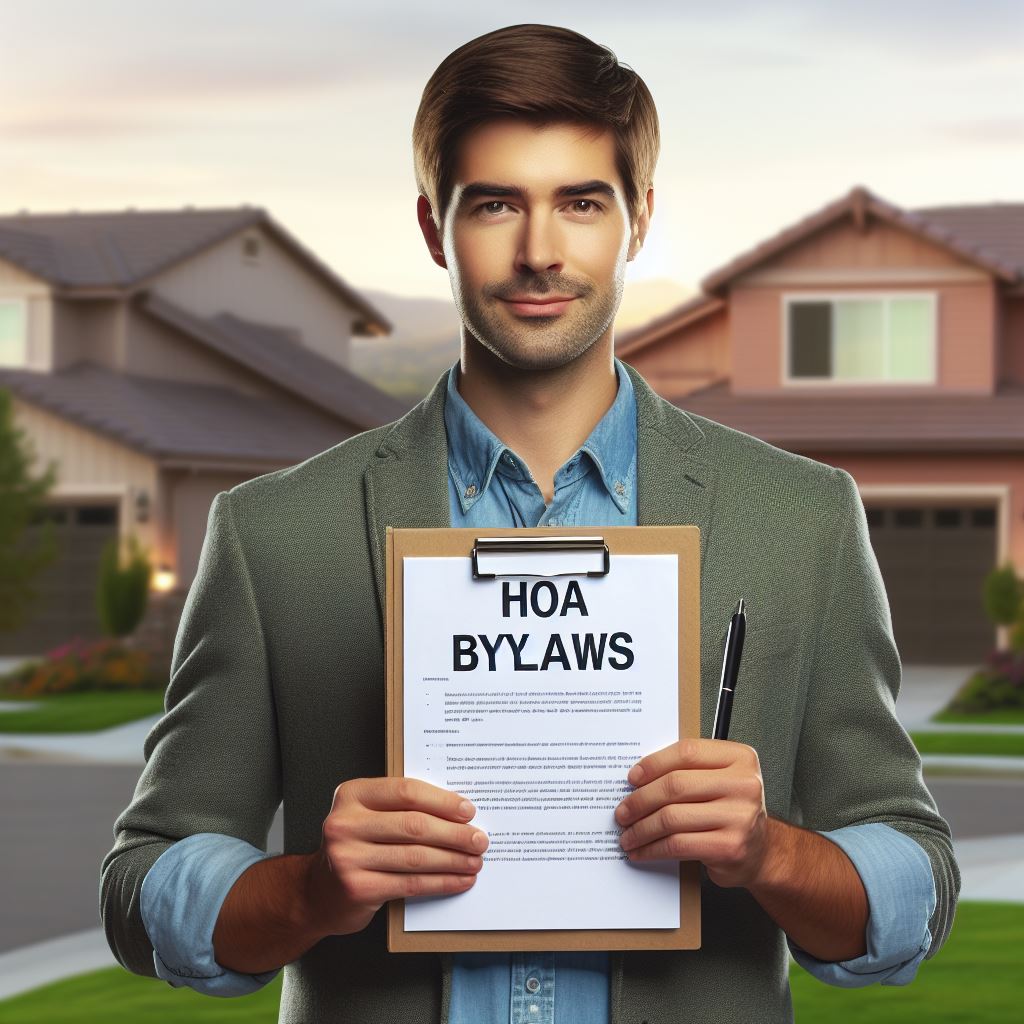Introduction
HOA bylaws are the rules and regulations that govern a homeowners association.
Amending HOA bylaws is important to address changing needs and ensure compliance with laws.
Process of amending HOA bylaws starts with identifying the need for changes.
HOA members must review and discuss proposed amendments before voting on them.
Prior notice must be given to all HOA members about proposed amendments.
HOA members should have the opportunity to provide input and raise concerns.
Majority vote is usually required to approve amendments to HOA bylaws.
Legal advice may be necessary to ensure amendments comply with applicable laws.
HOA board should communicate the amendments to all members and enforce the updated bylaws.
Education and awareness programs can help members understand the amended bylaws.
Regular review of HOA bylaws is essential to address new challenges and maintain a thriving community.
Ongoing communication is vital in ensuring compliance and resolving disputes related to the amended bylaws.
Amending HOA bylaws is crucial for an effective, transparent, and harmonious homeowners association.
By staying proactive and inclusive, HOAs can successfully adapt their bylaws to meet evolving needs.
Understanding the Current HOA Bylaws
Overview of the existing HOA bylaws
Before delving into the process of amending HOA bylaws, it’s crucial to have a solid understanding of the current bylaws in place.
These bylaws serve as the governing documents for the homeowners’ association (HOA), outlining rules, regulations, and procedures that members must adhere to.
Typically, HOA bylaws cover a wide range of topics, including property usage, architectural guidelines, membership rights and responsibilities, board structure and duties, assessment collection, and dispute resolution mechanisms.
By familiarizing yourself with these existing bylaws, you gain insight into the framework that governs your community.
Identifying the need for amendments
As communities evolve and circumstances change, it’s not uncommon for HOA bylaws to require updates or amendments to better serve the needs of homeowners and address emerging issues.
Some common reasons for amending bylaws include:
- Legal Compliance: Changes in state or local laws may necessitate updates to ensure that the bylaws remain legally compliant.
- Community Growth: With the growth of the community, new issues or concerns may arise that were not addressed in the original bylaws.
- Clarifications: Ambiguities or inconsistencies within the existing bylaws may require clarification to prevent misinterpretation or conflict.
- Technological Advances: Advancements in technology may require updates to address issues such as electronic voting or communication methods.
Assessing the reasons and goals for amending the bylaws
Before initiating the amendment process, it’s essential to assess the reasons behind the proposed changes and establish clear goals.
Some key questions to consider include:
- What specific issues or concerns prompted the need for amendments?
- How will the proposed changes benefit the community as a whole?
- Are there any unintended consequences or potential conflicts that need to be addressed?
- What input will be sought from community members during the amendment process?
By carefully evaluating the reasons and goals for amending the bylaws, HOA boards can develop well-informed proposals that foster transparency, fairness, and community engagement.
Planning and Preparation
A successful amendment to the HOA bylaws requires careful planning and thorough preparation.
To ensure a smooth process, follow these key steps:
Forming a committee or task force
- Assemble a group of dedicated homeowners who are willing to contribute their time and effort.
- Assign specific roles and responsibilities to each committee member to streamline the process.
- Establish clear communication channels to facilitate collaboration and transparency.
Researching state and local laws regarding HOA bylaws
- Familiarize yourself with the governing laws related to HOAs in your specific state or locality.
- Consult legal professionals or seek guidance from local authorities to ensure compliance.
- Understand the legal framework that governs bylaw amendments to avoid potential legal complications.
Conducting a thorough review of the current bylaws
- Obtain a copy of the existing bylaws and carefully review each provision and clause.
- Identify any outdated, ambiguous, or conflicting sections that require immediate attention.
- Note any provisions that may hinder community growth or cause unnecessary homeowner burdens.
Identifying areas in need of amendment
- Based on the review, pinpoint specific sections or clauses that require modification.
- Prioritize amendments based on their significance and potential impact on the community.
- Consider soliciting feedback from homeowners to identify common concerns or areas for improvement.
Setting specific goals and objectives
- Establish a clear vision of what you hope to achieve through the bylaw amendments.
- Define specific, measurable, achievable, relevant, and time-bound (SMART) objectives.
- Ensure that the goals align with the overall mission and values of the HOA and its residents.
By following these essential planning and preparation steps, your committee can lay a solid foundation for successful HOA bylaw amendments.
Read: The Role of HOA Boards Explained

Drafting the Amendments
Outlining the proposed changes
Firstly, when drafting the amendments to the Homeowners Association (HOA) bylaws, it is essential to outline the proposed changes clearly and concisely.
This step ensures that all modifications are properly identified and organized.
Ensuring clarity and consistency in language
Next, it is vital to ensure clarity and consistency in the language used throughout the amendments.
By using concise and straightforward wording, homeowners will be able to understand the proposed changes easily.
Consulting legal experts if required
In some cases, consulting legal experts may be necessary to ensure that the amendments comply with all applicable laws and regulations.
This step helps avoid any potential legal issues in the future.
Obtaining feedback and input from community members
Once the amendments are drafted, it is crucial to seek feedback and input from community members.
This can be done through public meetings, questionnaires, or online platforms, allowing homeowners to voice their opinions and concerns.
Incorporating suggestions and revisions
Based on the feedback received, it is essential to carefully consider and incorporate relevant suggestions and revisions into the amendments.
This demonstrates transparency and inclusivity within the HOA community.
Read: HOA Fees: What Are You Paying For?
Communicating with Homeowners
A crucial aspect of amending HOA bylaws is effectively communicating with homeowners throughout the process.
It is essential to keep them informed and engaged to ensure a smooth and transparent transition.
Here are some key steps to follow:
Notifying homeowners about the proposed amendments
Start by providing a formal notice or letter to all homeowners, clearly stating the intent to amend the bylaws.
Include details about the purpose and potential impact of the proposed changes.
Scheduling informational meetings or virtual sessions
Organize in-person meetings or virtual sessions to discuss the proposed amendments in detail.
This allows homeowners to directly engage with board members and gain a comprehensive understanding of the proposed changes.
Presenting the reasons and objectives behind each proposed change
During the meetings or virtual sessions, provide a thorough explanation of the reasons and objectives driving each proposed amendment.
This helps homeowners comprehend the necessity and potential benefits of the changes.
Addressing concerns and answering questions
Allocate time during the meetings or virtual sessions to address any concerns raised by homeowners.
Take their questions seriously and provide accurate and clear answers to ensure transparency and ease any anxieties or confusion.
Providing opportunities for homeowners to give feedback
Create a platform for homeowners to offer their feedback on the proposed amendments.
Effective communication with homeowners is essential throughout the amendment process to ensure transparency and maintain trust within the community.
Regular updates should be provided via various channels, including newsletters, emails, community forums, and the association’s website.
Remember that not all homeowners may be able to attend the meetings or virtual sessions, so it is crucial to make documentation available for those who were unable to participate.
Consider recording the sessions and sharing the recordings along with meeting minutes for broader accessibility.
Additionally, appoint a dedicated point of contact within the board to handle homeowner inquiries and concerns related to the proposed amendments.
Overall, transparency, clear communication, and a willingness to listen are vital when engaging with homeowners during the amendment process.
By keeping homeowners informed, addressing their concerns, and providing opportunities for feedback, the HOA can foster a collaborative environment and successfully navigate any bylaw changes.
Read: Understanding Your Rights in a Condo
Voting and Implementing the Amendments
Establishing the voting process and requirements
In order to amend the HOA bylaws, it is crucial to establish a clear and fair voting process.
The process should include guidelines on who is eligible to vote and how the voting will be conducted.
Determining the quorum needed for a valid vote
A quorum refers to the minimum number of members required to be present for a vote to be valid.
It is essential to determine the quorum needed to ensure that the voting results accurately represent the wishes of the homeowners.
Sharing the proposed amendments and voting instructions with homeowners
Before proceeding with voting, it is important to inform homeowners about the proposed amendments and provide them with clear instructions on how to cast their votes.
Transparency and clarity in communication are key to ensure an informed decision-making process.
Setting a reasonable timeframe for casting votes
Homeowners should be given sufficient time to review the proposed amendments and cast their votes.
Setting a reasonable timeframe will ensure that everyone has a fair chance to participate and express their opinions.
Verifying and announcing the voting results
Once the voting period has ended, it is crucial to verify the votes to ensure the accuracy of the results.
The voting outcome should then be promptly announced to the homeowners, promoting transparency and trust within the community.
Documenting the amendments and updating the official bylaws
After the voting process is complete, it is important to document the approved amendments and update the official bylaws accordingly.
This helps to provide a record of the changes made and ensures that everyone is aware of the updated rules and regulations.
Read: Coastal Property Laws and Regulations
Post-Amendment Responsibilities
A successful amendment to HOA bylaws not only brings about change but also imposes various responsibilities on the HOA board and management.
These post-amendment responsibilities ensure that the changes are effectively communicated, understood, and enforced among homeowners.
Informing homeowners about the approved amendments
Upon the approval of amendments, it is crucial for the HOA to inform all homeowners promptly.
This can be done through multiple channels, such as official written notifications, community meetings, newsletters, and the HOA’s website or online portals.
Clear and concise communication is key to ensure all residents are aware of the changes.
Educating homeowners about their rights and obligations under the amended bylaws
Along with informing homeowners about the approved amendments, it is equally important to educate them about their rights and obligations under the new bylaws.
This can be achieved through educational materials, workshops, or even one-on-one sessions, providing homeowners with a comprehensive understanding of their updated responsibilities within the community.
Ensuring proper enforcement and compliance with the new bylaws
A post-amendment responsibility of the HOA board is to ensure the proper enforcement and compliance with the newly amended bylaws.
This may involve establishing new systems, guidelines, or even appointing dedicated committees to oversee compliance.
Consistent enforcement will help maintain a harmonious living environment for all residents.
Periodic evaluation and review of the bylaws
After implementing amendments, the HOA should periodically evaluate and review the effectiveness of the bylaws.
This evaluation can help identify any unforeseen issues or areas of improvement that may require further modifications.
Regular review ensures that the bylaws remain up-to-date and adaptive to changing community needs.
Considering future amendments based on changing needs and circumstances
The dynamic nature of communities may call for future amendments to the HOA bylaws.
The HOA board should remain proactive in assessing the changing needs and circumstances within the community and, if necessary, initiate the amendment process.
Regular communication with homeowners can help identify areas that may require modifications in the future.
All in all, the responsibilities that arise post-amendment are vital for the successful implementation and maintenance of HOA bylaws.
Informing homeowners, educating them about their rights, ensuring compliance, periodically evaluating the bylaws, and considering future amendments collectively contribute to a well-functioning and thriving community.
Conclusion
Throughout this guide, we’ve delved into the crucial process of amending HOA bylaws.
These governing documents serve as the backbone of any homeowners association, shaping the community’s rules, regulations, and overall atmosphere.
By recognizing the significance of keeping these bylaws relevant and up-to-date, HOA members can ensure their community thrives.
Amending HOA bylaws offers numerous benefits, including adapting to changing community needs, addressing emerging issues, and enhancing property values.
By staying proactive and responsive to the evolving dynamics within the community, HOAs can foster a more harmonious living environment for all residents.
Every member has a stake in the community’s future, and their input is invaluable in shaping its direction.
Whether it’s attending meetings, voicing concerns, or contributing ideas, each member plays a crucial role in the democratic process of amending bylaws.
By fostering open communication, collaboration, and transparency, HOAs can ensure that amendments reflect the collective interests and aspirations of the community as a whole.




